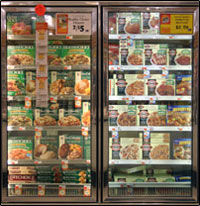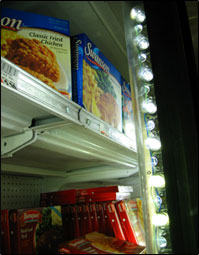|

Lighting Supermarket Freezers with LEDs (2006)

Left: Fluorescent-lighted freezer with an
average illuminance of 2871 lx.
Right: LED-lighted freezer with and average illuminance of 2470 lx.
The LED freezer provided an even illuminance uniformity across the freezer case. This led to greater preference for the LED freezer, even at a lower average illuminance level.

White LEDs of different distributions were used to effectively and uniformly illuminate the freezer interior. |
Supermarkets use lighted refrigerator and freezer cases to display a variety of foods and beverages. These cases account for nearly half of a supermarket’s annual electricity costs, with interior lighting systems using a quarter of the electricity required to operate the case. Nearly all commercial refrigerators and freezers use linear fluorescent lamps. Although fluorescent lamps provide superior energy efficiency in many lighting applications, their use in commercial refrigeration is not ideal. Fluorescent lamps in this application exhibit a reduced light output of up to 25% and uneven lighting on the products. These problems are a result of ineffective lamp operation at cold temperatures, the lack of optics to direct the light, and poor configuration and mounting location within the freezers.
LEDs may provide a better solution. LEDs do not suffer the same drop in light output under cold temperatures that fluorescent lamps do. The current luminous efficacy (the amount of light per watt of energy used) of LEDs—45 lumens per watt (lm/W) in 2006—is similar to the application efficacy of fluorescent lamps in commercial refrigeration. LEDs also can be customized to provide several distributions of light to provide more even lighting across freezer shelves. These differences mean that LEDs potentially can provide more efficient lighting.
The LRC first explored the potential of LEDs in commercial refrigeration through a previous laboratory study. To fully understand the effects and operation of LED lighting in commercial refrigeration, the LRC conducted a field study at an Albany, N.Y., area supermarket. The LRC investigated the use of white LEDs inside supermarket freezers with goals to:
- improve the light uniformity and visibility of merchandise inside supermarket freezers
- evaluate shoppers’ lighting preferences for supermarket freezers
- demonstrate the benefits of LED lighting technology in refrigerated display cases
- compare the energy usage of LED lighting technology with traditional fluorescent technology in this application
- monitor product sales under new and traditional lighting
EXPERIMENT
The LRC worked with LED systems manufacturer GELcore and freezer manufacturer Tyler Refrigeration to build a prototype four-door, supermarket-style freezer outfitted with white LED lighting. The prototype freezer and a matching fluorescent-lighted freezer were installed side by side in the freezer aisle at a Price Chopper supermarket. The study ran for 18 months.
Average illuminances across the freezer shelves at the time of the installation.
Measurements were taken on the face of the products inside the freezers.
| |
LEDs at 100%
light output |
LEDs
dimmed |
Fluorescent |
Average
illuminance |
2470 lx |
2148 lx |
2871 lx |
SHOPPER SURVEYS
Shoppers were surveyed about their opinions of each of the prototype freezers and their preferences for one over the other. A questionnaire asked shoppers to rate the appearance of the merchandise and the overall brightness, comfort, and evenness of the freezer lighting. Shoppers rated the freezers with the LEDs at both full light output and dimmed by approximately 15%. (The fluorescent-lighted case remained at full light output at all times.) More than 300 shoppers were surveyed.
Overall, shoppers highly rated the LED freezer on all questions asked. At full light output, 86% of shoppers stated that they preferred the LED freezer lighting over all other freezer lighting in the aisle. When the LEDs were dimmed, shoppers still preferred the LED freezer lighting, with 68% saying they liked it the most. In each instance, the LED freezer provided lower illuminance levels than the test fluorescent freezer, yet shoppers still deemed the LED freezer as brighter and preferred.
The even illuminance uniformity and the higher correlated color temperature (CCT) of the LED lighting likely contributed to the perception that the LED freezer was brighter. This indicates that light levels within a freezer case could be reduced for added energy savings if the distribution and uniformity were even across the freezer shelves and products and a higher CCT were used.
SALES ANALYSIS
The LRC analyzed product sales from each prototype freezer. During the course of the study, the position of the freezers was switched to collect sales of the same products under each type of lighting. Sales data from the test store were compared with sales of the same products from a control store.
A statistical analysis of sales in the test freezers compared with sales at a control store showed no significant difference in sales due to lighting. This finding is consistent with previous lighting-and-sales studies conducted by the LRC and by other researchers.
ENERGY ANALYSIS
Power measurements were taken in the laboratory and in the field to provide an energy usage comparison between LED and fluorescent lighting in supermarket freezers.
At the beginning of the project in 2003, it was known that white LEDs at that time would not provide an energy-efficient solution compared with traditional fluorescent lamps. However, the LRC expected that by the completion of the study, white LED efficacy would reach a higher level, making them more energy efficient.
Power measurements of the prototype freezers in the lab showed that energy consumption was higher for the LED lighting system operated at both 100% and 50% control voltage. Decreasing the control voltage by 50% reduced the light level by approximately 30%.
Calculated kilowatt hours per door per day for the prototype freezers.
Based on measurements conducted in the lab, before installation at the field site. The luminous efficacy of the LEDs in this freezer, built in 2003, is approximately 25 lm/W.
| |
LEDs 100%
control voltage |
LEDs 50%
control voltage |
Fluorescent |
| kWh/door/day |
16.56 kWh |
14.98 kWh |
14.04 kWh |
CONCLUSIONS
The potential exists now for LED lighting in commercial refrigeration to match or even surpass fluorescent lighting in terms of shopper satisfaction. Shoppers in this study showed greater preference for the LED freezer, most likely because of its better illuminance uniformity and higher CCT. In this study, it is likely that better uniformity allowed the LED freezer to have a lower average light level than the fluorescent-lighted freezer, yet be deemed brighter, more even, more appealing, and more comfortable. While the average illuminance level of the fluorescent freezer was higher, the uneven distribution led to areas at the center of each glass door that were roughly half of the average LED light level in the same location. Because the center of the door is where products are most visible, this may have led to the increased brightness perception of the LED freezer.
At a dimmer light level, LEDs are now at a “threshold” efficacy where they fall slightly below the energy consumption of fluorescent lighting without sacrificing shopper satisfaction. Using 2006 LED light sources with a luminous efficacy of 45 lm/W, a dimmed LED lighting system would show a savings of 14 W over fluorescent lighting in a four-door freezer.
Energy usage comparison of LED and fluorescent lighting in commercial refrigeration.
|
Field Study Light Sources (2003) |
Current Light Sources (2006) |
| LED luminous efficacy |
25 lm/W a |
45 lm/W a |
| LED lighting system watts, 4-door freezer – 100% light output |
652 W b |
362 W d |
| LED lighting system watts, 4-door freezer – Dimmed |
496 W b |
276 W d |
| Fluorescent lighting system watts, 4-door freezer (100% light output, 58 W per lamp, 5 lamps) |
290 W c |
290 W c |
| Energy savings with dimmed LEDs |
–206 W |
14 W |
a Luminous efficacy of light source stated by manufacturer, not system efficacy.
b Lighting system watts were measured
c Lighting system watts were calculated
d Estimated by dividing the measured field study wattage by 1.8, the ratio of 2003 LED luminous efficacy to 2006 LED luminous efficacy.
TECHNICAL REPORTS AND PUBLICATIONS
ASSIST. 2008. ASSIST recommends...Recommendations for Testing and Evaluating Luminaires for Refrigerated and Freezer Display Cases. Vol. 5, Issue 1. Troy, N.Y.: Lighting Research Center.
Narendran, N., J. Brons, and J. Taylor. 2006. Energy-efficient Alternative for Commercial Refrigeration. Project report prepared for the New York State Energy Research and Development Authority.
Narendran, N. 2006. Field Test DELTA Snapshots: LED Lighting In Freezer Cases. Troy, N.Y.: Lighting Research Center.
RELATED NEWS
"LED Lighting Gives Appeal to Frozen Foods" — LRC Newsletter, February 2007.
LRC Project Sheet (PDF)
LRC Press Release: Lighting Research Center Studies LED Technology for Supermarkets — October 24, 2004
SPONSORS
Project Sponsor: New York State Energy Research and Development Authority (NYSERDA)
Equipment Sponsors: GELcore, Tyler Refrigeration
Site Sponsor: Price Chopper Supermarket
|


